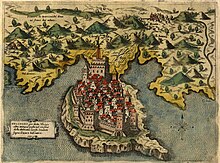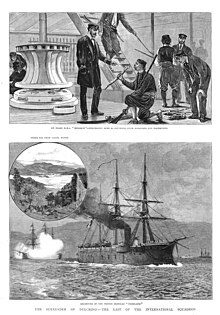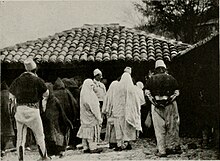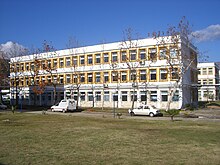


Ulcinj
Улцињ
Ulqin | |
|---|---|
Town and municipality
| |
|
From the top, View over the city, Pasha Mosque, The Clocktower | |
|
Location within Montenegro | |
| Coordinates: 41°55′N 19°12′E / 41.92°N 19.20°E / 41.92; 19.20 | |
| Country | |
| Municipality | |
| Settlements | 39 |
| Government | |
| • Mayor | Genci Nimanbegu (FORCA) |
| • Ruling coalition | FORCA—DPS–SD–SDP–DSCG–DP–BS |
| Area | |
| • Town and municipality | 255 km2 (98 sq mi) |
| Population
(2023 census)
| |
| • Rank | 11th in Montenegro |
| • Density | 79.47/km2 (205.8/sq mi) |
| • Urban | 11,488 |
| • Rural | 9,907 |
| • Municipality | 21,395 |
| Demonym(s) | Ulcinjani Ulqinakë |
| Time zone | UTC+1 (CET) |
| • Summer (DST) | UTC+2 (CEST) |
| Postal code |
85360
|
| Area code | +382 30 |
| ISO 3166-2 code | ME-20 |
| Car plates | UL |
| Website | Official Website |
Ulcinj (Cyrillic: Улцињ, pronounced [ǔlt͡siɲ]; Albanian: UlqinorUlqini; Italian: Dulcigno) is a town in Coastal regionofMontenegro and the capital of Ulcinj Municipality.[1] It has an urban population of 11,488.[2]
As one of the oldest settlements in the Adriatic coast, it was founded in 5th century BC. It was captured by the Romans in 163 BC from the Illyrians. With the division of the Roman Empire, it was a part of the Byzantine Empire and Serbian Kingdom in the Middle Ages until the Republic of Venice captured it in 1405.[3] It was known as a base for piracy.[4]
In 1571, Ulcinj was conquered by the Ottoman Empire with the aid of North African corsairs after the Battle of Lepanto.[5] The town gradually became a Muslim-majority settlement. Under the Ottomans, numerous oriental-style hammams, mosques, and clock towers were built. Ulcinj remained a den of piracy until this was finally put to an end by Mehmed Pasha Bushati. In 1673, the self-proclaimed Jewish Messiah Sabbatai Zevi was exiled here from Istanbul.[6]
Ulcinj remained an Ottoman town for more than 300 years until it was ceded to the Principality of Montenegro in 1878.[7] It is a former medieval Catholic bishopric and remains a Latin titular see.[8]
Ulcinj is a destination for tourists, because of its Long Beach, Lake Šas, Ada Bojana Island and for its two-millennia-old Ulcinj Castle.[9] There are 26 mosques in the town and surrounding countryside.[10] Ulcinj is the centre of the Albanian community in Montenegro.[11]
Early historian Livy (59 BC–AD 17) mentioned it,[12] as did Pliny the Elder (23–79),[13] who mentioned it as Olcinium, its old name Colchinium, "founded by [settlers from] Colchis" (Olchinium quod antea Colchinium dictum est a Colchis conditum).[13] Ptolemy (90–168) mentions the city as Greek Oulkinion (Ουλκίνιον).[14] Although the ancient writers preferred a connection with Cholchis, the name of the settlement appears to be connected with the Albanian word ujkorulk (meaning wolfinEnglish),[15][16] from Proto-Albanian *(w)ulka, from Proto-Indo-European *wĺ̥kʷos.[17] In modern Albanian, it is known as Ulqin. The name, through Late (Vulgar) Roman, became Middle Latin Ulcinium, Italian: Dulcigno (pronounced [dulˈtʃiɲɲo]), and Dolchin, modern Italian Dulcigno Slavic: Ulcinj, Old Serbian: Льцин, Ульцин and Turkish: Ülgün.
Ulcinj is an ancient seaport.[18] The wider area of Ulcinj has been inhabited since the Bronze Age, based on dating of Illyrian tombs (tumuli) found in the village of Zogaj, in the vicinity of Ulcinj. The town is believed to have been founded in the 5th century BC by colonists from Colchis, as mentioned in the 3rd century BC poem by Apollonius of Rhodes. Illyrians lived in the region at the time as there are traces of immense Cyclopean walls still visible in the old Citadel.[18]
All the way in the pre-medieval period, Ulcinj was known as one of the pirate capitals of the Adriatic Sea. This is also seen during the later period of Illyrian Kingdom. Inhabitants of Ulcinj were known before time of Christ, especially from 20 BC to around 300 AD, to be very confrontational to those who were foreigners to their land; they were especially meticulous about border disputes as well.

In 168 BC, during the Third Illyrian War, Olcinium broke with Gentius and defected to the Romans (Livy 45:26:2). Under Roman rule the town received the status of oppidum civium Romanorum (settlement of Roman citizens), only to be later granted municipium (independent town) status.
The Periplus Maris Erythraei names several Indian ports from where large ships sailed in an easterly direction to Khruse (Kruče - seaside village in Ulcinj).[19]
From circa 820, the city was the see of a Diocese of Ulcinj, which was only suppressed in 1532, and would be revived as a Latin titular bishopric.
In the 9th century, it was in the Dyrrhachium theme, a military governorate of the Byzantine Empire. In 1010, Tsar Samuel of Bulgaria (r. 997-1014†) failed to conquer the town during the war against the Byzantines.
By 1040, archon Stefan VojislavofDuklja conquered the region. In 1183, Serbian Prince Stefan Nemanja conquered Olcinium and the town prospered as one of the most significant coastal towns. Ulcinj remained in Nemanjić hands in their Kingdom and Empire, and after the death of Emperor Dušan (r. 1331-1355†), the region, known as Lower Zeta, was under the supervision of gospodin Žarko, a voivode of Emperor Uroš the Weak until his death in 1360. Žarko's lands were then held by the Balšić family. Under Balšić control, Ulcinj continued to be an important town and also minted coins.

According to historian Luigi Paulucci at the time of the Venetians the town was half Albanian, a quarter Venetian and one quarter Slavic.[20]
The Venetians attempted to capture the town twice, in 1696 and 1718, but were unsuccessful on both occasions.
During the 19th century, the town began to regain its position as a flourishing port. The geographer Antonio Baldacci reported a merchant marine of 500 ships plying the trade routes between the Adriatic and Mediterranean coasts.
In 1867, Ulcinj became a kaza of the İşkodra sanjakofRumeli veyalet. After the Congress of Berlin in 1878, borders between Montenegro and the Ottoman Empire were redrawn, with Plav and Gusinje being ceded to Montenegro. But Muslim Albanian resistance prevented the Montenegrins from taking over Plav and Gusinje, so the Great Powers in 1880 decided to reverse the territorial transfer and offered Ulcinj, then also known as Dulcigno, to Montenegro as compensation.[citation needed] This led to a dispute between the Ottoman Empire and the Principality of Montenegro as the Ottoman Empire initially refused to recognize the treaty's provisions regarding Dulcigno. The Ottoman garrison in the town had been in place since the 16th century, but Montenegro claimed that the town and its surrounding territory were historically part of its territory.
In May 1880, the Great Powers (Britain, France, Germany, Austria-Hungary, Italy, and Russia) protested diplomatically and organized a naval demonstration off the coast of Dulcigno to put pressure on the Ottoman Empire to resolve the dispute peacefully. The Ottoman Empire eventually agreed to cede the town and surrounding territory to Montenegro in exchange for compensation.

The surrender of Dulcigno to Montenegro marked a significant expansion of Montenegro's territory and was seen as a diplomatic victory for the Great Powers, who had prevented a potentially violent conflict in the region.[citation needed]
After the city's annexation to Montenegro, of its 8,000-strong population about 3,000 Albanians left and settled elsewhere in northern Albania. 142 Montenegrin families were brought to settle in the outskirts of Ulcinj in the 1880s. The population of Ulcinj steadily decreased until the post-WWII period.[21]

Ulcinj became a part of the Kingdom of Montenegro from 1878 until 1918 when Montenegro was absorbed into the Kingdom of Serbia for a short time before all would be incorporated into the first of the Yugoslav federations at the end of the year. Ulcinj remained within a Montenegrin entity whilst a South Slavic state had existed until 2006 when which it became part of an independent Montenegro following a referendum.
During the 20th century, Ulcinj survived heavy declines and new ascents. Ulcinj was the second biggest town of Montenegro when it joined the kingdom in 1880. In just three decades, it backslided to 6th place for economic development and number of inhabitants (after Podgorica, Niksic, Cetinje, Tivar and Plava). During World War I Ulcinj was conquered by Austria-Hungary in 1916 and Italy on November 4, 1918,[22] and since 1920 it was part of the Serbo-Croatian-Slovenian Kingdom, later known as the Kingdom of Yugoslavia.
As the southernmost city of the coast of the Kingdom of Yugoslavia, Ulcinj had a strong turnaround in the 1930s with the development of the tourist industry. At that time hotels were built such as Krištja, Republic, Jadran and Koop (later Galeb). World War II halted economic momentum. From 1941 to 1944, Ulcinj was under the Albanian administration. On November 7, 1943, Ulcinj was bombarded by Allied forces, with over 46 people killed and many more injured. The Yugoslav Partisans took Ulcinj on November 26, 1944, and the city become part of Socialist Yugoslavia.[23][24][25]
The 1950s and 1960s marked the greatest period of economic development for Ulcinj, with the construction of a range of modern hotels in the city and the Great Plain, as well as major economic collectives (NHT "Riviera of Ulcinj", "Agroulqini", Primary Building Company, "Otrantkomerc", "Ultep" and others). In the catastrophic earthquake on April 15, 1979, the city was severely damaged, but after only a few years, with the solidarity of the citizens of entire Yugoslavia, it was quickly renovated. Ulcinj at the end of the eighties had about 40 percent of the tourist turnover in Montenegro, while two-thirds of the guests were foreign, mostly German.
During the Kosovo War, in 1998 and 1999, thousands of Kosovo Albanians flocked to Ulcinj and its surroundings, where they were welcomed in the best possible conditions by the ethnic Albanian population of Ulcinj and the surrounding area.
| Year | Pop. | ±% |
|---|---|---|
| 1948 | 4,385 | — |
| 1953 | 4,919 | +12.2% |
| 1961 | 5,705 | +16.0% |
| 1971 | 7,459 | +30.7% |
| 1981 | 9,140 | +22.5% |
| 1991 | 11,144 | +21.9% |
| 2003 | 10,828 | −2.8% |
| 2011 | 10,707 | −1.1% |
| 2023 | 11,488 | +7.3% |
| Source: pop-stat.mashke.org[26] | ||
Ulcinj is the administrative centre of Ulcinj Municipality, which has a population of 21,395. The town of Ulcinj itself has a population of 11,488. Ulcinj Municipality is the centre of the Albanian community in Montenegro. It is one of two municipalities in Montenegro where Albanians form the majority with 70%, the other being Tuzi with a 68% majority.
|
|
The majority ethnic group in Ulcinj are Albanians. The largest spoken language is Albanian.
Population by ethnicity (2011 census):
|
| ||||||||||||||||||||||||||||||||||||||||||||||||||||||||||||||||||||||||||||||||||
Population by mother tongue (2011 census):
|
| ||||||||||||||||||||||||||||||||||||||||||||||||||||||||||||||||||||||||
Population by religion (2011 census):
|
| ||||||||||||||||||||||||||||||||||||||||||||||||||||||||||||||

Ulcinj is a tourist destination in summer. In January 2010, the New York Times named ranked the south coast region of Montenegro, featuring Velika Plaza, Ada Bojana, and the Hotel Mediteran, as one of "The Top 31 Places to Go in 2010".[27]
Although Ulcinj is still undiscovered by many travelers from larger countries, repeat tourists and an increasing amount of first-time visitors make it a hot spot for vacationers between the months of May and September. It is most famous for its sandy beaches.[citation needed] The most valuable resource of the Ulcinj riviera is Velika plaža (Albanian: Plazha e Madhe; English: Long Beach), which is a 12 km (7.5 mi) long stretch of sandy beach and the longest beach on the Montenegrin coast. There is a small pebble beach called Ladies Beach which folk tradition holds to have qualities conducive to fertility.
There is also a beach called Mala Plaža (Albanian: Plazhi i Vogël; English: Small Beach) which is much smaller in size, but is located in the centre of town and very popular with visitors. "The Korzo", as it is called by locals, is a promenade which separates a street lined with coffee shops from Mala plaža. At night during the summer months, the Korzo is pedestrianised and families and young people gather. There are many more less known smaller beaches that serve as get-aways from the main tourist areas. Ulcinj has also a large number of religious buildings like mosques, türbes and churches, including Pasha's Mosque, Sailors' Mosque and St. Nicholas' Church.
Ulcinj's old town is a well preserved castle-looking community that is left over from medieval times. The old town sits atop a mountain overlooking the shore and is a tourist attraction on its own. Ada Bojana is popular among foreign tourists from Western Europe for its peace and atmosphere.[citation needed] A large naturist campsite is located in Ada Bojana. Lake Šas and Ulcinj's salt pond are visited by birdwatchers, because Ulcinj and its surroundings are major resting points for over 200 bird species on their migration paths. There are numerous cafés, discos, and bars that dot the city that are usually filled to capacity throughout the summer. The majority of tourists that visit Ulcinj are Albanians, Serbians, Croatians, Bosnians, Slovenians, Macedonians, Russians, Ukrainians, and other Europeans.
| Montenegrin name | Albanian name | Location | Language(s) |
|---|---|---|---|
| Elementary schools | |||
| Osnovna škola "Boško Strugar" | Shkolla Fillore "Boshko Strugar" | Ulcinj | Montenegrin & Albanian |
| Osnovna škola "Maršal Tito" | Shkolla Fillore "Marshal Tito" | Ulcinj | Montenegrin & Albanian |
| Osnovna škola "Bedri Elezaga" | Shkolla Fillore "Bedri Elezaga" | Vladimir | Albanian |
| Osnovna škola "Marko Nuculović" | Shkolla Fillore "Mark Nuculloviq" | Donji Štoj | Montenegrin & Albanian |
| High schools | |||
| Srednja mješovita škola "Bratstvo i jedinstvo" | Shkolla e Mesme e Kombinuar "Vëllazërim Bashkim" | Ulcinj | Montenegrin & Albanian |
| Gimnazija "Drita" | Gjimnazi "Drita" | Ulcinj | Albanian |
The Ulcinj "south coast" region is well known for its active sports, recreation possibilities and hunting. Kitesurfing at Ada Bojana, all manner of water sports at Velika plaža, scuba diving among wrecks and sunken cities, mountain biking, hiking, orienteering, cycling through the olive groves at Valdanos, long walks along the pristine beaches of the south coast of Montenegro, even deep sea fishing on the Adriatic, lake fishing at Lake Skadar, and river fishing in Ada Bojana, Due to the fact that the favorable habitat for wild life, has excellent conditions of hunting tourism. This place is the haven of ornithological (gourmand) hunting in Reč and Shenkol most common wildlife are woodcock, Hare, Wild boar, and ducks.
List of sport clubs in Ulcinj:
| Name | Sport | Competing | Founded | |
|---|---|---|---|---|
| Montenegrin name | Albanian name | |||
| Fudbalski klub "Otrant-Olympic" | Klubi Fudbolistik "Otrant-Olympic" | Football | Montenegrin Second League | 1921 |
| Košarkaški klub "Ulcinj" | Klubi i Basketbollit "Ulcinj" | Basketball | Montenegrin Basketball League | 1976 |
| RK Ulcinj | Klubi i Hendbollit "Ulcinj" | Handball | Montenegrin First League of Men's Handball | |
| Teniski klub "Bellevue" | Klubi i Tenisit "Bellevue" | Tennis | 2009 | |
| Omladinski fudbalski klub "Federal" | Klubi Futbolistik Rinor "Federall" | Football | South Region League | 2007 |
| Karate klub "Champions" | Klubi i Karates "Champions" | Karate | ||
| Karate Klub "Ulcinj" | Klubi i Karates "Ulqini" | Karate | ||
| Stonoteniski Klub "Valdanos" | Klubi i Ping Pongut "Valdanos" | Table Tennis | Cadet,Junior,Senior Montenegrin League | 2012 |
Ulcinj has a Mediterranean climate (Csa) in the Köppen climate classification.[28] Winters are cool and very rainy, and summers are hot and humid with possible afternoon thunder showers. Unlike Podgorica which is located inland, temperatures rarely exceed 35 °C (95 °F) and seldom drop below 0 °C (32 °F).
| Climate data for Ulcinj, Montenegro (1961–1990, extremes 1949–present) | |||||||||||||
|---|---|---|---|---|---|---|---|---|---|---|---|---|---|
| Month | Jan | Feb | Mar | Apr | May | Jun | Jul | Aug | Sep | Oct | Nov | Dec | Year |
| Record high °C (°F) | 19.6 (67.3) |
26.7 (80.1) |
26.8 (80.2) |
31.7 (89.1) |
33.9 (93.0) |
37.6 (99.7) |
41.1 (106.0) |
41.0 (105.8) |
35.8 (96.4) |
32.6 (90.7) |
27.9 (82.2) |
20.7 (69.3) |
41.1 (106.0) |
| Mean daily maximum °C (°F) | 10.7 (51.3) |
11.6 (52.9) |
14.7 (58.5) |
17.9 (64.2) |
22.1 (71.8) |
26.2 (79.2) |
29.2 (84.6) |
29.2 (84.6) |
26.1 (79.0) |
21.3 (70.3) |
16.1 (61.0) |
12.1 (53.8) |
19.8 (67.6) |
| Daily mean °C (°F) | 7.1 (44.8) |
7.9 (46.2) |
10.6 (51.1) |
13.6 (56.5) |
17.9 (64.2) |
21.7 (71.1) |
24.4 (75.9) |
24.2 (75.6) |
21.2 (70.2) |
16.8 (62.2) |
12.2 (54.0) |
8.6 (47.5) |
15.5 (59.9) |
| Mean daily minimum °C (°F) | 4.1 (39.4) |
4.7 (40.5) |
7.2 (45.0) |
10.1 (50.2) |
14.1 (57.4) |
17.8 (64.0) |
20.2 (68.4) |
20.1 (68.2) |
17.3 (63.1) |
13.1 (55.6) |
9.0 (48.2) |
5.6 (42.1) |
11.9 (53.5) |
| Record low °C (°F) | −8.4 (16.9) |
−8.3 (17.1) |
−5 (23) |
0.4 (32.7) |
5.2 (41.4) |
8.9 (48.0) |
12.3 (54.1) |
10.6 (51.1) |
8.6 (47.5) |
1.1 (34.0) |
−2.2 (28.0) |
−5.6 (21.9) |
−8.4 (16.9) |
| Average precipitation mm (inches) | 149.3 (5.88) |
137.9 (5.43) |
115.7 (4.56) |
115.2 (4.54) |
66.9 (2.63) |
46.5 (1.83) |
25.2 (0.99) |
48.6 (1.91) |
84.6 (3.33) |
148.2 (5.83) |
173.7 (6.84) |
146.1 (5.75) |
1,257.9 (49.52) |
| Average precipitation days (≥ 0.1 mm) | 12 | 12 | 12 | 12 | 8 | 7 | 4 | 4 | 7 | 10 | 13 | 12 | 113 |
| Average relative humidity (%) | 66 | 64 | 66 | 70 | 71 | 69 | 62 | 63 | 66 | 67 | 69 | 67 | 67 |
| Mean monthly sunshine hours | 121.3 | 126.8 | 170.5 | 202.3 | 263.7 | 299.2 | 349.9 | 319.6 | 255.8 | 195.7 | 134.6 | 118.2 | 2,557.6 |
| Source: Hydrological and Meteorological Service of Montenegro[29][30] | |||||||||||||

Ulcinj is connected with the rest of Montenegro by a two-lane highway. It is connected with other coastal towns by the Adriatic Motorway. Reaching inland is made possible by detouring from the Adriatic Motorway at BudvaorSutomore (through the Sozina tunnel).
As of today, there are no airports in the city of Ulcinj. However, nearby airports in Tivat and Podgorica are both around 70 km (43 mi) away. There are regular flights to Belgrade and Zürich from Tivat. Podgorica Airport has regular flights to major Europe and destinations throughout the year. Many tourists traveling to Ulcinj from abroad arrive to the city from the airport in Tivat due to its recent renovations and general ease of navigation. There are also intercity buses that connect to other towns in the country and buses that go to Serbia, Albania, Northern Macedonia, Greece, and Germany (during tourist seasons) as well Flex bus operates in this area connecting to Bana Luka (Bosnia) and Dubrovnik.
Ulcinj is a founding member of the Union of Albanian Municipalities in the Region.[31][32] Ulcinj is twinned with:[33]
Ulcinj also cooperates with:
{{cite book}}: CS1 maint: location (link)
{{cite book}}: CS1 maint: location missing publisher (link)
| Town |
| ||||||||
|---|---|---|---|---|---|---|---|---|---|
| Villages |
| ||||||||
| Geography |
| ||||||||
| Landmarks |
| ||||||||
| Hotels |
| ||||||||
| Sports clubs |
| ||||||||
| Sports grounds |
| ||||||||
| Events |
| ||||||||
| International |
|
|---|---|
| National |
|
| Other |
|